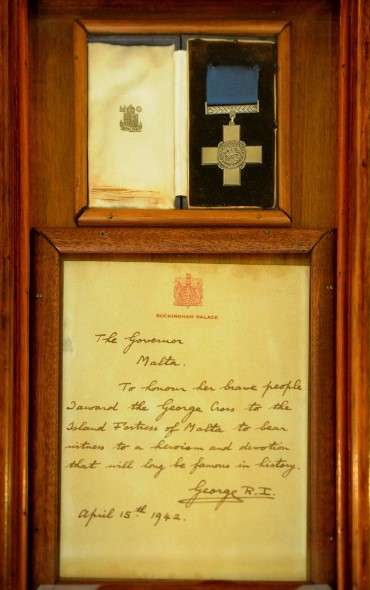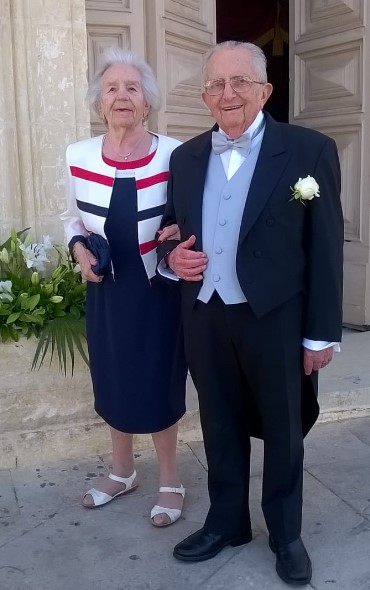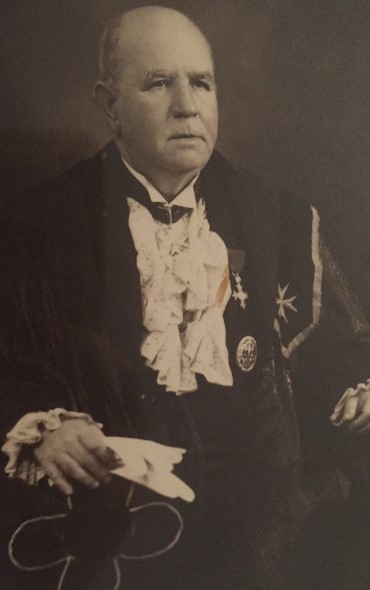Experience a first hand account by a local who witnessed the momentous ceremony in Valletta.
“To honour her brave people I award the George Cross to the Island Fortress of Malta to bear witness to a heroism and devotion that will long be famous in history.”
With these words, written by his own hand, King George VI acknowledged the immeasurable sacrifice and courage of this small island as it withstood some of the heaviest bombings during World War II.

©viewingmalta.com - DOI
Malta was the first British Commonwealth country ever to receive this award, which was instituted by King George VI in 1940. It came at a time when Malta was enduring daily incursions from the Axis forces, in a bid to bring the island to its knees. Malta’s geographic location between Italy and North Africa was of strategic importance for the Allies to sustain their North African campaign.
Between February and June 1942, the Siege of Malta intensified, and the island endured 154 days and nights of continuous bombing. It was enough to crush the spirit of the nation. Hunger was threatening to break the people, as only two out of 24 merchant supply ships managed to make it safely into harbour. Fuel was restricted to military use, and ammunition was running so low that only a few rounds could be fired each day from anti-aircraft guns. The people spent so much time in underground shelters that their health was beginning to decline. Malnutrition and scabies became widespread. Medical supplies were scarce. Over 10,000 buildings were destroyed or damaged.
Field Marshal Kesselring had made his plans for Malta abundantly clear: he wanted the island to be taken and insisted that his Fliegerkorps II (2nd Air Corps) were capable of achieving this. In early 1942, Hitler ordered Malta to be “neutralised” in preparation for a German invasion.
It was in the middle of this seemingly never-ending nightmare that King George VI felt compelled to reach out to the Maltese, to recognise their heroism and fighting spirit. Replying to the King’s handwritten letter, then Governor of Malta Sir William Dobbie wrote: “By God’s help Malta will not weaken but will endure until victory is won.” And endure it did.
While the award was announced on 15th April 1942, it would not be presented to the Maltese until 13th September of that year due to the incessant bombing. During a lull from the air raids, barely recovering after the merchant vessel Ohio famously limped into Grand Harbour a month earlier bringing desperately needed supplies, the people of Malta congregated that Sunday morning amid the rubble in St George’s Square outside the Grandmasters Palace to witness the simple but poignant ceremony.
Chief Justice Sir George Borg, as the highest civil authority on the island after the governor (at the time there was no local representative government) received the award on behalf of the Maltese people from the hands of new Governor Lord John Gort who had replaced Governor Dobbie. His wife, Lady Beatrice, watched from the balcony of what was then known as the Governor’s Palace while their children, Joyce, then aged 15, Rosemarie, 13 and Ivan watched the ceremony from the roof of the Garrisons Library opposite.
Sir George Borg’s son-in-law, Dr Antoine Cachia, was 16 years old at the time, and he remembers the day clearly and with evident pride. “Being in the square in Valletta on that memorable day, one felt a sense of unity inspired by a feeling of relief and satisfaction,” recalls Dr Cachia, now aged 92.

Dr Antoine Cachia & Joyce, daughter of Sir George Borg
“There was an element of surprise at how His Majesty King George VI, after having followed what we had been through, decided to give the nation this signal honour. It is the highest civilian decoration comparable to the Victoria Cross as the highest military decoration, and only one of two instances awarded to a group of people,” continues Dr Cachia.
“In the crowds of people, stories went around about personal experiences during the unprecedented enemy attacks, day and night. It was very significant of the daily aerial bombardments that the square was a dumping area of the rubble from the bombed buildings and houses. The other alternative was the sea,” he adds.
Dr Cachia went on to explain how a dais was erected in the middle of the square, on which the Governor presented the award to Sir George Borg. “As chief justice, Sir George Borg was the first citizen of Malta. It was only just that he should receive the award, as he was the public leader of the nation against the German and Italian war machine.”

Sir George Borg (photo given to his daughter Joyce in 1948)
However, the honour and privilege of his position came with a heavy responsibility. “As such, he was the number one victim in the event of an invasion. He was warned about this, together with some High Court judges. Never for one instant did he flinch at his duties,” points out Dr Cachia. “He accepted this honour with great personal pride, as it was a crowning glory for his aspirations in the British cause. This was, however, something personal, as he kept his own ‘human and common touch’ to himself. For this he was greatly respected both by his colleagues on the Bench and his former political adversaries.”
The George Cross was added to the national flag on 28th December 1943, where it appeared on a blue background. The design was changed after Malta obtained independence from the British Empire on 21st September 1964, but the George Cross remains to this day on the left canton of the flag.
Today, the George Cross is proudly displayed at the National War Museum in Fort St Elmo, Valletta, which houses a collection going back to 2,500 BC tracing Malta’s military role in history. The museum’s World War II section also features the iconic biplane fighter Gloster Sea Gladiator N5520 FAITH which became a symbol of Malta’s air defence during the war, and the jeep President Franklin D. Roosevelt used during his visit to Malta in December 1943.
The text of King George VI’s letter is engraved in marble on the facade of the President’s Palace in Valletta, while the original letter is archived at the National Library.
A replica of the award is also displayed at the Malta at War Museum in Couvre Porte, Vittoriosa (Birgu) which features exhibits related specifically to World War II. The museum sits on top of an extensive labyrinth of underground tunnels and chambers which served as an air raid shelter to hundreds of people. The museum is also home to the original wartime film Malta GC, produced by the Crown Film Unit in 1942 at the height of the Siege of Malta. It was made on order from King George VI and released soon after the George Cross was awarded to Malta. Sir Arnold Bax, the King’s Musician, composed the music for the soundtrack, with narration by celebrated British actor Sir Laurence Olivier.
Featured image: George Cross Re-Enactment - viewingmalta.com / Sergio Morana